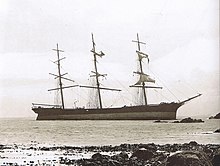Wandsbek (ship, 1885)
The Wandsbek was originally a British, from 1896 German steel full-rigged ship , which was driven onto the rocky coast at Lizard Point on the southwestern tip of Cornwall in 1900 and had to be abandoned.
Construction and technical data
The three-master was on 19 January 1885 the hull number 289 on the yard of Alexander Stephen & Sons in Glasgow from the stack and was given the name Ardencaple . The ship was 77.7 m long and 11.9 m wide and measured 1,782 GRT . The owner was the timber wholesaling company and shipping company Edmiston & Mitchells in Glasgow.
Ardencaple
The Ardencaple drove freight to India, Australia and South America.
On September 8, 1888, she was at sea, about 600 nautical miles northeast of Recife ( Brazil ), at position 2 ° 55 ′ 58.8 ″ S , 27 ° 27 ′ 0 ″ W in a catastrophic collision with the British full ship Earl Wemyss involved. The Ardencaple under Captain Thomas Guthrie was on the voyage from Liverpool to Calcutta , the Earl Wemyss under Captain Colquhoun, whose wife and three children were also on board, was on the journey home to England. At night around 21:00 in fine weather and under all sails rammed Ardencaple the Earl of Wemyss , although their navigation lights already some time had seen before, amidships immediately before the mizzen mast and cut its steel hull almost into two parts . The Earl of Wemyss was first with a strong list against the Ardencaple , but started already on her stern to sink, then lay down suddenly on the other side and sank very fast with the stern first, where 16 people were killed. The 12 survivors, including the captain. were picked up by one of the Ardencaple 's boats, which was lowered immediately after the collision .
The Ardencaple itself lost its foremast - rigging and suffered severe damage to the bow, so she took a lot of water and the bow sank deeper. Some of the cargo stowed in the front was thrown overboard to improve buoyancy. The leak was sealed with canvas , but in daylight the following morning it turned out to be insufficient. The crew spent the entire September 9th strengthening the front bulkhead from behind and removing the damaged rigging. Around 8 p.m. a ship came into view, which came alongside after an emergency signal had been raised . The survivors of the Earl Wemyss were handed over, and then the Ardencaple's crew insisted on being allowed to leave their ship; the men feared a bulkhead rupture, which would have caused a quick demise. Only Captain Guthrie and the helmsman (first mate) Cameron remained on the ship as they believed they could save it.
They found on the morning of September 10th that they were drifting westward and, unable to set enough sails to reach the coast of Pernambuco , set a course for the island of Fernando de Noronha , about 300 nautical miles west of them , about 350 km east of mainland Brazil. With the mizzen mice sail , the remains of the mainsail and a mizzen mizzen sail on the forestay , they sailed by day and turned by night. On September 15 they reached Fernando de Noronha, where they anchored in a safe place about 1200 m from the coast. They stayed there for 90 days until the help they requested came. After carrying out the most important emergency repairs, the Ardencaple was towed by the tug Stormcock to Greenock (Scotland), which was reached on January 19, 1889.
Wandsbek
In 1896, the Ardencaple , which had meanwhile returned to sea, was sold to the German shipping company Knöhr & Burchard in Hamburg and renamed Wandsbek . She mostly sailed to South America and ports on the South and North American west coast.
In May 1900 she called at the southern English port of Falmouth (Cornwall) to receive her instructions for continuing to Portland (Oregon) on the northwest coast of the USA, but received an order to go to Liverpool first . The tug Dragon towed the ship out of the harbor on May 26th and to the south of Cape Lizard . However, the towline was thrown off too early and the Wandsbek was, before it could really pick up speed, by the wind at Maenheere Reef south of Lizard Point at position 49 ° 57 '23.4 " N , 5 ° 12' 23.4" W driven onto the rocks and had to be abandoned.
The remains of the wreck are still there today in about 10 m water depth not far from the coast.
On September 22, 1900, Knöhr & Burchard bought the British Ancyra , built in 1892, from the shipping company GT Soley & Co. in Liverpool as a replacement and named it Wandsbek .
Individual evidence
- ^ Glasgow University Archive Services: Records of Edmiston & Mitchells.
- ↑ http://www.clydesite.co.uk/clydebuilt/viewship.asp?id=3350
- ↑ The Earl of Wemyss of the London shipping company Alexander McAlister ran on March 15, 1884. Robert Duncan & Co. in Port Glasgow launched. At 75.3 m long, 11.5 m wide and 6.5 m draft , she was measured at 1,499 GRT and 1,411 NRT . ( Earl Wemyss, at www.clydesite.co.uk )
-
^ The Ardencaple-Earl Wemyss Collision. The Press, Canterbury, Volume XLVI, Issue 7286, April 16, 1889, p.6 (Report of the captain of Ardencaple ) (Engl.), March 19, 2013 called up to
further press reports are u. a. in The Sydney Morning Herald (NSW: 1842-1954), December 13, 1888, p. 10: The Earl Wemyss and Ardencaple Collision and in the Oakland Star, December 28, 1888: The Earl Wemyss and Ardencaple Collision; 16 persons drowned . - ↑ A Diver's Guide to the Shipwrecks of the Lizard; Part 1: The Western Lizard ( Memento from July 21, 2011 in the Internet Archive )
